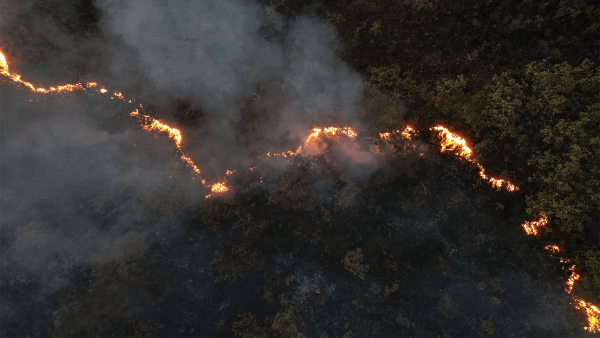Pulling the Global Fire Alarm
UMD’s Unique Forest-Monitoring Capabilities Revealed an Alarming Wildfire Spike
The world’s forests fell at a record pace in 2024, with the oldest ones in tropical areas suffering the heaviest blows from a massive surge in fires, according to a report released this week by the World Resources Institute (WRI) and based on satellite data analysis from a University of Maryland lab.
Old-growth, or “tropical primary” forests—delicate ecosystems dense with life—were destroyed last year at a rate equal to 18 soccer fields a minute, consuming an area nearly the size of Panama, the report showed. Cold, primarily coniferous boreal forests of Alaska, Canada, Russia and elsewhere were also hit hard.
“It was the first year we saw it simultaneously—the south and the north burning so strongly at the same time,” said geographer Peter Potapov, a research scientist in UMD’s Department of Geographical Sciences involved with the report.
Maryland Today sat down with Potapov and geographical sciences Professor Matthew Hansen, who together lead UMD’s Global Land Analysis and Discovery (GLAD) Lab, to explain why the world seems to be burning, UMD’s vital contribution to monitoring global conditions and what it would take to save the trees.
A complex set of economic and environmental conditions sparked the fires.
Conflagrations that consumed tropical forests appear to have been mainly driven by human factors. “The fires were related to industrial agriculture, mining, and logging valuable timber mainly for the U.S. or Europe,” Potapov said. Even traditional land uses, such as smallholder agricultural clearing, can now pose a forest fire risk with a hotter, drier climate. As temperatures rise and droughts become more frequent, even comparatively wet tropical forests are becoming more prone to wildfire than ever before, the researchers said.
Policies around the world to prevent forest fires are inconsistent or nonexistent.
Beyond the obvious challenges of fighting fires across vast swaths of wildland, creating policy and political will to prevent their outbreak is a puzzle. “It took heavy smoke in Sao Paulo before Brazil really started thinking about the use of fire,” Hansen said. While some countries have taken steps to prevent fires at particularly dangerous times of the year, others blithely look the other way—or even act counterproductively. “When a village in Guyana where children had high mercury counts in their blood complained to the government they’d been overrun with illegal miners from Brazil, the government just gave the miners visas,” Hansen said.
Primary tropical forests are treasures of unparalleled biodiversity.
There are more species of plants and animals we haven’t discovered in the primary forests of the Amazon, Congo Basin and elsewhere than all known species, Hansen said. It’s not just about protecting wildlife or exotic ecosystems—these forests also contain raw materials for new pharmaceutics and therapeutics, he said. Moreover, said Potapov, they contain so much biomass that when they burn, the resulting climate effect is far greater than when a northern forest burns. According to the report, last year’s fires released 4.1 gigatons of carbon—more than four times the emissions of all air travel in 2023.
Once they are gone, they don’t come back.
Protecting a primeval forest is similar to a team keeping a perfect record of wins—you only have to fail once to lose it. The rainforest biome is a finite resource, the researchers said, with no slowing of deforestation from land use and now a new increasing dynamic of fire added in recent years. Unlike northern forests, tropical primary forests aren’t adapted to fire, the researchers said. A single burning, or a period of using the area for agriculture, can permanently end its existence as a forest; the outcome might be a savanna, with mixed trees and grassland and vastly lower biodiversity.
“People need to develop a new mindset about fire, but as we saw from last year’s data, that doesn’t seem to be happening,” Hansen said. Potapov added, “I am pessimistic that we are just documenting the disappearance of primary forests .”
UMD is a central global source of information about the fate of forests.
As grim as the data is, it wouldn’t exist without the GLAD Lab’s ongoing analysis of high-resolution Landsat satellite data through the Global Forest Loss project. The GLAD Lab team (Hansen, Potapov, Svetlana Turubanova, and Alexandra Tyukavina) has released the state of the forest data every year since 2013. Research groups, practitioners and even agribusinesses worldwide rely on the group's detailed mapping of global changes, distributed by UMD, WRI and other organizations.
Processing petabytes of data and feeding it to supercomputers isn’t always a cold, technical project; a Peruvian woman who works with Indigenous communities in her homeland visited the GLAD Lab several years ago to learn more about where the data comes from.
“She wanted to see the computers where it was made, and she teared up when we showed her,” Hansen said. “She brings hard copies to these villages and shows them the progression of forest lost on their own land. The reveal is a tension-filled event.”
Image: Fires spread through the Brasilia National Forest in the middle of the dry season in July 2024. Last year saw a record extent of forest loss globally, with the area destroyed by fires surging. By AP Photo/Eraldo Peres
This article, written by Chris Carroll, was originally published in Maryland Today.
Published on Tue, 05/27/2025 - 09:09


